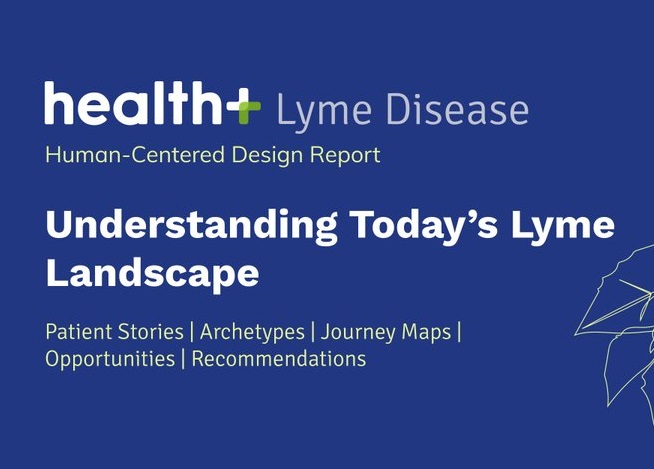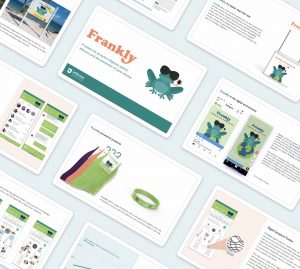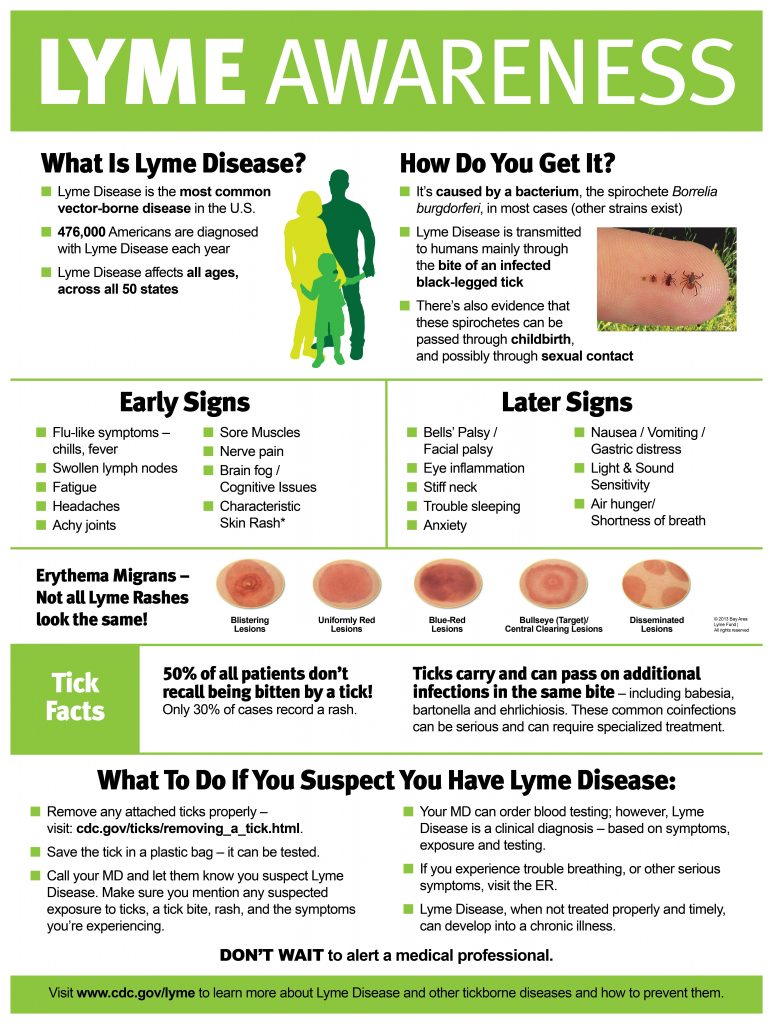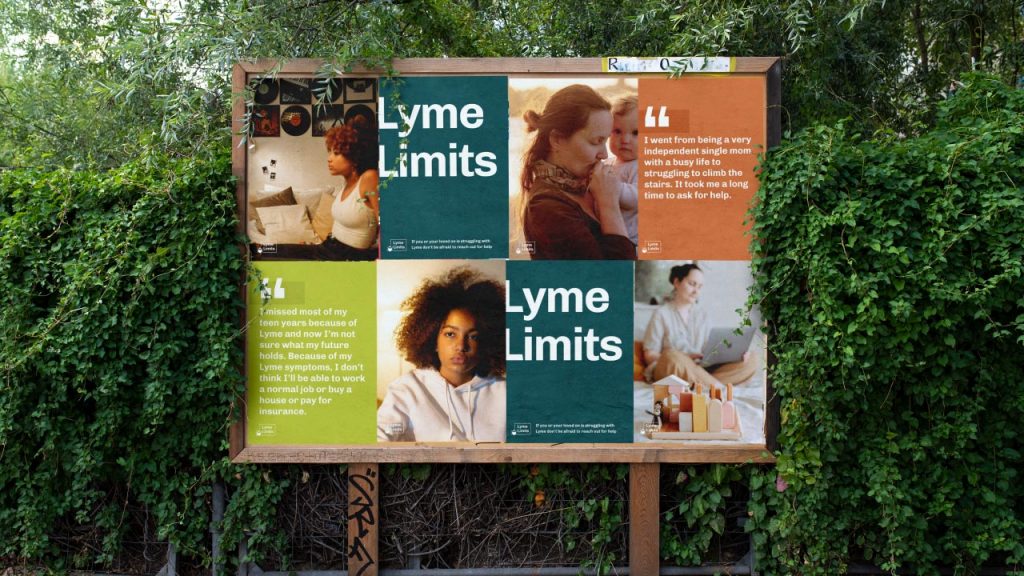“Health-plus” report details Lyme challenges and proposes solutions

By Angela Hopkins and Cecilia Ramirez
Four innovative solutions address the need for added awareness, improved diagnostics, and increased understanding of Lyme disease.
Coforma is a design agency working with the LymeX Innovation Accelerator (LymeX), a public-private partnership between the Department of Health and Human Services (HHS) and the Steven & Alexandra Cohen Foundation.
We collaborated with LymeX to deliver the Health+ Lyme Disease program–geared towards understanding patients’ experiences and uncovering opportunities to alleviate challenges.
To gain an accurate picture of these challenges, we interviewed Lyme patients, caregivers, leaders, and medical professionals. In all, we conducted 47 interviews with participants from 20 states. Five Lyme-endemic regions of the country were represented, as well as some areas with only isolated cases.
The results of what we found are included in this 123-page report, detailing different patient experiences from diagnosis through treatment. It presents in-depth patient archetypes, journeys, opportunities, and recommendations that can be used to improve the lives of those living with Lyme.
The diagnostic journey
As the report illustrates, the Lyme disease diagnostic journey can be a crucial and influential phase in the patient’s overall experience with Lyme disease. The length of this process can vary from one day to potentially decades, with the prospect of emotionally, financially, and physically devastating both patients and caregivers.
Through this period of trying to find diagnoses, a patient or caregiver could experience discrimination, misdiagnoses, and mistreatment, forcing them to become their own advocate in the search for answers. The resulting stress and trauma can cause additional harm, leaving the patient even more vulnerable to symptoms of Lyme disease.
Following the report’s publication, four individuals and groups, including a Coforma design team, responded to those insights by creating unique solutions to help people with Lyme. These solutions, outlined below, directly address opportunities brought about by the report. They address awareness, prevention, and diagnostic gaps around Lyme disease today.
The new solutions range from awareness campaign needs, to policy adjustments, to new technology and design prototypes.
Solution 1: Frankly
The Masters of Science (MS) Health Communication Design Program at Jefferson University created Frankly, a system and an app. It’s designed as a one-stop platform to assist with diagnosis, prevent the onset of chronic symptoms, and provide support to patients with chronic Lyme disease.
“Many patients with Lyme disease experience roadblocks on a journey to diagnosis that can take months, or even years,” said the team.

“Frankly” is a system, app, awareness campaign, and product line designed by the Masters of Science (MS) Health Communication Design Program at Jefferson University .
Their system was built with the goal of ensuring a more timely diagnosis of Lyme disease and empowering patients throughout their journey with data, advocacy, and community support.
Through human-centered design, their solution aims to elevate patients’ voices and close the gaps in the diagnostic process. It also includes an awareness campaign aimed at the prevention of new Lyme disease cases. It targets millennials—those aged 25 to 40–who may not know much about Lyme disease, but may be at high risk of tick exposure.
Why millennials? People in this age group spend a lot of time outside, where they are at risk of contracting Lyme disease. Furthermore, this is the age of parents with young families. They have the potential to influence their children and create awareness in younger generations who are active outdoors.
Solution 2: Lyme Awareness
Anne Kupillas, a Lyme disease patient, presented a comprehensive Lyme awareness poster highlighting Lyme disease’s main symptoms and important facts.
“I strongly believe that awareness of Lyme disease is a big pain point, the first link in the chain,” Anne noted. “A comprehensive poster that highlights main symptoms and important facts is direly needed.”
Lack of awareness about the realities of Lyme disease today, in line with current science, was a driving force in Anne’s solution.
“My goal is the display of this poster in every single doctor’s office, hospital waiting room, ER, and school nurse’s office. This poster would raise awareness of Lyme realities for both medical professionals and the public,” she said.
Anne’s poster informs people of the current state of Lyme disease as a major health issue in the US and indirectly dispels myths related to the likelihood of contracting Lyme disease, as well as the common symptom indicators of a Lyme infection.
“Had this poster been on the office walls of ANY ONE of the 14 doctors that I saw prior to being properly diagnosed, I would have recognized myself in it—and so might have my doctors,” she points out.
“And I would have likely gotten on the right track to treatment much, much sooner. Which would have saved me and the government money, and precious time, literally years of my life lost to this illness.”
Solution 3: TacTicks Program
Monica White, a patient advocate who co-founded the Colorado Tick-Borne Disease Awareness Association, presented a series of white papers. They highlight the need for tick-bite prevention, education, and control resources and standardization across the different departments, agencies, and regions across the US. These white papers include:
- Federal Natural Resources Managers Tick Bite Prevention
- Federal Wildland FireFighter Tick Bite Prevention
- Medical Center of Excellence for Tick-Borne Disease
Monica’s work points out that federal employees and natural resource workers whose daily duties place them in high exposure to tick habitats are at an increased risk of tick bites and the resulting tick-borne diseases.
“The lack of resources that were experienced by me personally when I was employed as a federal wildlife biologist and wildland firefighter. I didn’t know what I didn’t know until it was too late,” said Monica.
She recommends an update to all federal health and safety handbooks and training with standardized tick-bite prevention, direction, and guidance that has received input from a tick-borne disease patient or patient advocate. Her goal is to reduce the incidence of illness and disability among federal and natural resource employees.
Lyme Limits: A Lyme Awareness Concept
The solution created by Coforma includes marketing pieces aimed at vulnerable audiences and locations. It uses research findings to help address specific areas of prevention, awareness, and diagnostic responses that represent pain points for people who experience a tick contact and subsequently contract Lyme.
“The research we conducted with people living with Lyme, caregivers, leaders, and medical professionals revealed numerous insights around the impact of Lyme,” said Maddy Hamel, who led Coforma’s research for Health+ Lyme Disease.
“We decided to focus on raising awareness about persistent symptoms, targeting areas where Lyme has been considered non-endemic but still poses a risk—near city parks, on beaches, and on job sites, for example,”
Coforma’s solution aims to spread further awareness about Lyme disease and the potential for persistent symptoms. Its core components build on this to address the need for awareness in areas not typically associated with Lyme and climate change’s effect on the spread of Lyme-carrying ticks.
“Our goal was to build empathy and understanding around people experiencing Lyme symptoms,” said Maddy.
About the Health+ Program
Today’s healthcare system needs improvement. Hardworking clinicians, policy makers, providers, and government personnel often work in disconnected groups, engaging patients and families separately and neglecting their different perspectives in the collective effort to improve outcomes for patients and their families.
Healthcare could benefit from introducing Human-Centered Design (HCD) approaches to help people solve complex problems through thoughtful interactions and research methods.
With this challenge in mind, Coforma developed Health+ (“health plus”): a program that utilizes HCD research to better understand the high-impact health issue placed in focus.
Each Health+ engagement is part of an ongoing series of research and health-a-thon cycles. Health+ builds a more supportive infrastructure around the most medically vulnerable populations in the US through private-public collaboration, cross-industry dialogue and collaboration, and creative problem solving with the potential for solutions around policy, code, and systems.
Angela Hopkins is Coforma’s Director of Strategic Communications. Cecilia Ramirez is Content Editor for Coforma. Jefferson University team members include Eli Steiker-Ginzberg, Iman Morsy, Alyssa Liegel, Stephen Andreo, Eva Floyd, and Meghan Garrity. Follow Coforma on Twitter: @coformaco.






















We invite you to comment on our Facebook page.
Visit LymeDisease.org Facebook Page